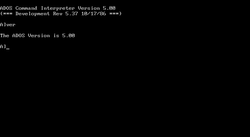IBM OS/2 1.0 revision 7.68.17
| Build of OS/2 1.0 | |
 | |
| Architecture | x86 16-bit |
|---|---|
| Compiled on | 1987-02-26 |
IBM OS/2 1.0 revision 7.68.17 is a build of OS/2 1.0. This build is an early FOOTBALL compile, as it displays the old codename PIGSKIN on the boot screen, intending to include changes to improve the overall performance of the operating system. It is based on the SIZZLE revision 7.68.18 build and thus the kernel hasn't been updated. Only the debug version of this build is currently available to the public.
Bugs and quirks[edit | edit source]
Booting[edit | edit source]
This build requires a debugger connected to COM2 in order to boot, as the boot loader breaks into the debugger and expects user input in order to continue booting. It is unknown if any known hypervisors are known to boot the build.
To boot this build, enter the "g" command on the debugger.
Slack space[edit | edit source]
Rather bizarrely, this build contains part (approximately 22 files) of the source code of this build, as well as tools for IBM regression testing, in its slack space, with many files being completely intact (this is likely because the disk is only about half full, and seemingly these files being deleted was one of the last things that happened to this disk):
There are also many internal tools in the slack space, in varying states of integrity.
Source code in slack space directory structure[edit | edit source]
/DOS/ (unknown first character, but likely DOS) directory[edit | edit source]
- DPB.INC (vital information about the format of a disk drive)
- HEADER.INC (C.Header)
- LOADSTE.ASM (segment loading routines)
- V86MODE.ASM (support for switching between V86 and protected modes on the 80386)
- LINMGR1.ASM (Linear Memory Manager)
- SYSIMAIN.C (sysinit C routines to load and interpret EXE files)
/BIOS (partially corrupted or empty, unknown first character but likely BIOS) directory[edit | edit source]
- SYSIMAIN.C (again)
/INC/ (unknown first character, but likely INC based on contents)[edit | edit source]
- BASEMID.INC
- CLKADJ.INC
- CMACROS.INC
- DOSCALLS.INC
- ERRNO.INC
- ERROR2.INC
- HISTORY
- INFOSEG.INC
- STRUC.INC
- UTILMID.INC
- UTLERROR.INC
- VERSION.INC
/REGRESS/ directory[edit | edit source]
- MSC.EXE (unknown version)
- CL.EXE (unknown version)
- BIOSINC.INC
- BIOSMAC.INC
- BIOSSECS.INC
- BUFFER.H
- BUGBITS.ASM
- BUGCODE.INC
- BUGFLG.INC
- CON3XDEV.ASM
- DEVHDR.H
- DEVSYM.B
- DMA765.INC
Judging by the mostly-alphabetical order of the files, there were likely more files here, but the rest of directory entry was corrupted and overwritten with another file. This is also proven by the survival of two other files likely from this directory:
Files that had their directory entries obliterated but at least partially survive (in regress folder)[edit | edit source]
- IBMRGRS.BAT
- REGRESS.BAT
Multitasking MS-DOS 4 connection[edit | edit source]
Upon inspecting some of the surviving source code in the slack space of this disk (specifically the file LOADSTE.ASM):
PAGE ,132
TITLE
LOADSTE - segment loading routines
NAME LOADSTE
;*** MT-MSDOS Segment loading routines
;
; Copyright (c) 1983, 1984 by Microsoft
;
; SCCSID = @(#)loadste.asm 10.3 87/02/26
;
;
; The segment loading routines handle the loading of
; new .EXE file format segments.
;
; The module table entry is allocated in the file LOAD.ASM
it can be observed that the code is copyrighted 1983–1984 (long before the Joint Development Agreement that allegedly started the development of OS/2), and is labelled as "MT-MSDOS Segment loading routines". It is obvious from context that MT-MSDOS stands for "Multitasking MS-DOS", and considering the critical nature of a "segment loader" to an operating system, especially one that started out in x86 real mode, it is obvious that OS/2 and Multitasking MS-DOS 4.0 are based upon the same codebase and that one directly became the other.


